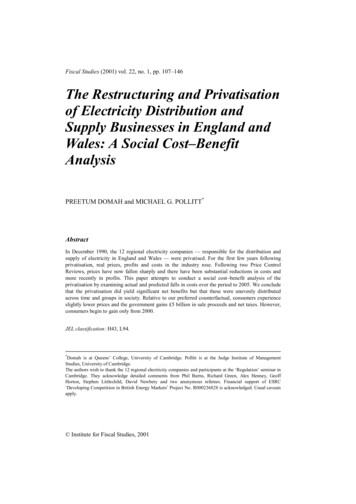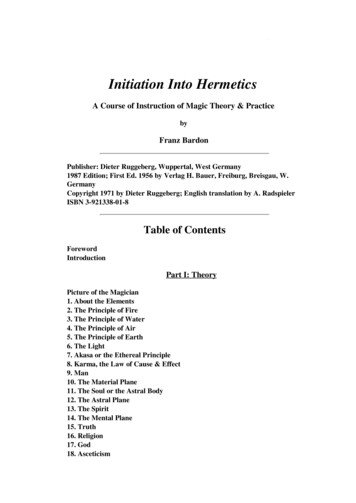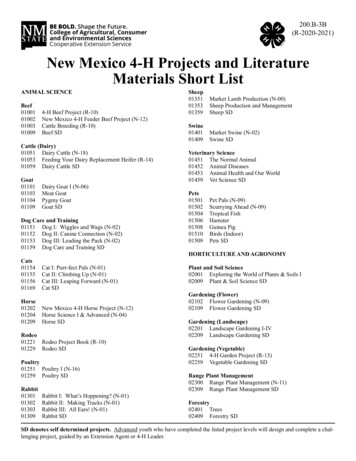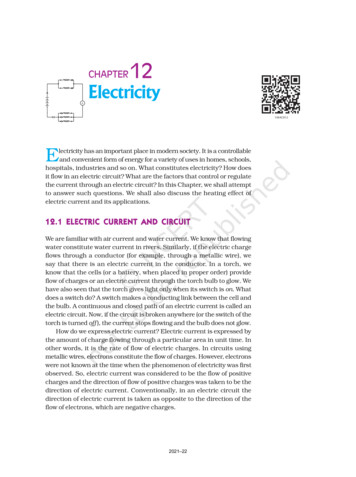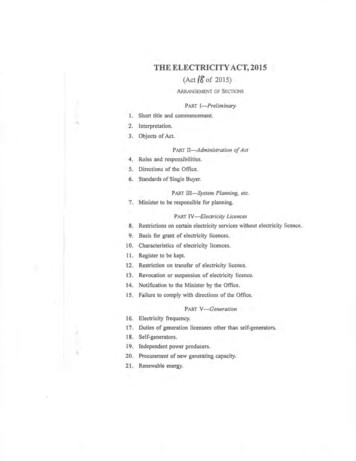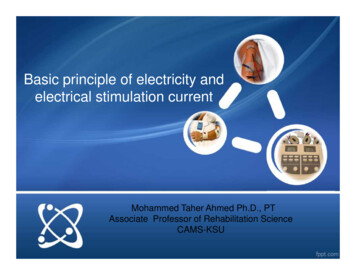
Transcription
Basic principle of electricity andelectrical stimulation currentMohammed Taher Ahmed Ph.D., PTAssociate Professor of Rehabilitation ScienceCAMS-KSU
Learning OutcomesUnderstand the basic concepts, terminology, and physiology of electricalstimulation and be able to differentiate among them.Guide the selection of optimal current parameters for effective and safedelivery of electrical stimulation to accomplish therapeutic treatment goals.Understand adjustment of treatment parameters to meet the needs andresponses of individual patients to the application of electrical stimulation toaccomplish therapeutic treatment goalsDescribe the principles behind the application of electrodes for electricalstimulation to elicit a comfortable level of stimulation and discuss what can bedone to improve patient comfortBe able to create a safe environment when using electrical equipment
OutlineIntroduction and HistoryElectrical Current Parameters Current types Waveforms Time-Dependent Parameters Other Electrical Current ParametersEffects of Electrical Currents Stimulation of Action Potentials in Nerves/Muscles Wound healing/inflammatory PainIndications for the Use of E-StimContraindications and Precautions for the Use of E-StimCurrents Application Technique Patient Positioning Electrode Type Electrode Placement General Instructions for Electrical Stimulation Documentation
Electrical stimulationElectrotherapy Application of electricalenergyfortherapeuticpurposesElectrical current is a flow of charged particlesElectrical stimulation Application of therapeutic electricalcurrent devices to stimulateexcitable tissues, with the aim ofproducing physiological reactionfor therapeutic benefits.ACRONYMExplanationEMSElectrical muscle stimulationESTRElectrical stimulation fortissue repairNMESNeuromuscular electricalstimulationTENSTranscutaneous electricalnerve stimulationFESFunctional electricalstimulation
Electrical Current Parameters Current types Waveforms Time-Dependent Parameters Other Electrical Current Parameters Current density Tissue impedance
Current TypesDef.ShapeDirect current(DC)Alternating Current(AC)Pulsed current (PC)iscontinuousunidirectionalflowofe-’stoward ( ) poleThe e- flow in alternatingdirections in both sides ofisoelectric line from (–) and( ) pole.pulsatile currentAn interrupted current, whereby thecurrent flows in a series of pulsesseparated by periods when nocurrent flows.can take on the directionalitycharacteristics of AC or DC current.MonophasicBiphasicMonophasic or biphasicTypes“GalvanicCurrent can be symmetrical,current”asymmetrical e.g.Interrupted direct TENS,currentor“interruptedgalvanic”Groups of pulses are interrupted forshort periods of time (inter-pulseintervals) & repeat. Russian currentInterferential e;Pain reliefNeuromuscular stimulationWound healingPain reliefNeuromuscular stimulation.
Current typesDirectcurrent (DC)AlternatingCurrent (ACpulsatilecurrent
1-Alternating vs. Direct CurrentDirect currentchemicalreactionChemical burnAlternating currentPulsed currentNo- chemical reactionVery shortpulse durationReversingpolarityNo Chemical burn
WaveformsWaveform is a graphic representation of “shape, direction,amplitude, duration and frequency” of the electricalcurrent.1-Waveforms Shape:
Waveforms lPolyphasicAsymmetricalBalancedUnbalanced
Waveforms ClassificationMonophasicOne phase only ( or -)Current flows in one directiononly.BiphasicTwo phases ( and -)Current flows in both directions.Polyphasic (pulsatile)Many phases
Waveforms Classification
Time-Dependent ParametersPulseduration InterpulseintervalPhaseduration InterphaseintervalBurstduration Inter-burstintervalFrequency
FrequencyThe number of cycles or pulses per second.Frequency is measured in Hertz (Hz) for cycles orpulsesLowFrequency 1000HzMediumFrequency10000-10000MediumFrequency 10000Direct current (DC)/ GalvanicInterrupted direct current/faradic currentTranscutenous electrical nervestimulation (TENS)High Voltage Pulsed Current (HVPC)Didynamic CurrentInterferentialcurrentRussian currentUltrasoundShortwavediathermy
FrequencyTypes of musclescontraction andHigh frequency ( 60-120Hz)Acute painSpinal pain modulation 20HzSensorylevelFrequency20-35Hz 35HzmotorlevelIndividual twitchIndividual twitches become lessdistinguishable summationTetany muscle contractiondegree of mechanicaladaptionfatigue ,Lower frequency ( 20Hz )Chronic painSupra-spinal pain modulationamount of tissueimpedance
Pulse AttributesPulse: An individual waveform is referred to a pulseIt contains one , or more phases.It is measured in microseconds or milliseconds.Pulse duration (PD) pulse width:is the timeform beginning of first phase of pulse to the end of lastphase of a pulse “ On Time”Interpulse intervalis thetime between individual pulses “OFF Time”Phase durationis a duration of one phase of pulse “ on time”Interphase intervalThe time between phases of a pulse “OFF time”(F) Phase duration.(G) Pulse duration.
Pulse Attributes Shorter phase durations (150μsec) requires greater intensity (amplitude) toevoke an action potential. Longer phase durations (200μsec) requires less intensity (amplitude) to evokean action potential. Muscle contraction: Optimum duration – 100-500μsec Stimulation of denervated muscle: Optimum duration 10msec
4-Pulse attributesBurstA finite series of pulses flowing for a limited time,followed by no current flow.Burst period burst interval (BI) inter-burst interval (IBI).1-Burst interval (BI)is the length of the time during which burst occurs.2-Interburst interval (IBI)is length of the time between two successive bursts, andcurrent flow is “off”
4-Pulse ChargePhase chargeis the amount of electricalenergy delivered to the tissue witheach phase of each pulse which canbe measured in micro coulombs persecond (μC/sec).Phase charge relates to: Strength of the stimulus or intensity The potential for issue damage
Ramp up/ramp down timeRamp upThe ramp up time is the time it takes for thecurrent amplitude to increase from zero, at theend of the off time, to its maximum amplitudeduring the on time.raneged 1-8seconds (2-second)PlateauTime during which pulses remain at maximumpreset intensityRamp downis the time it takes for the current amplitude todecrease from its maximum amplitude during ontime back to zero
Concept check
Concept checkGive the name of each letter and define it, than explain it rolein clinical application of electricity for electrotherapy
Concept checkFABCDBGive the name of each letter and define it, than explain it rolein clinical application of electricity for electrotherapy
OTHER ELECTRICAL CURRENTPARAMETERS Current amplitude Current density Tissue impedance Polarity
Current AmplitudeIntensity (I) AmplitudeIs the rate of an (e-) flow through aconductor from cathode (-) to anode( ), per second.Measured in (mA 1/1,000 ampere) or1 amp 6.25 x 1018 e- / secPeak current amplitude :is the maximum (highest) amplitude form zerovalue of the phase of pulsePeak to peak amplitudeis the amplitude measured from the peak(maximum) of one phase to the peak(maximum) of next phase only for biphasiccurrent
Increase intensityCurrent AmplitudeIncreaseStrength of stimulation musclescontraction/IncreaseStrength of sensory perceptionIncreaseDepth of penetration to deepertissue(nerve & muscles)IncreaseNumber of motor unit recruitedCross-sectionaldiameter : Largediameter nervesdepolarize firstStronguncomfortableparesthesias,strong hesias,Tingling, prickling,pins and needlesLocation of thenerve: Superficialnerves depolarizefirst
Current Density (CD)The amount of current per unit areaElectrode distanceDetermines the CurrentDensityA placed closely electrodes ,high CD insuperficial tissues.A spaced apart electrodes.high CD inthe deeper tissue(nerve& muscle).Electrode SizeDetermines the Current Density
Tissue impedance Ohm’s law showing a comparisonof constant current and constantvoltage stimulators: I V/RVolt (V) a unit of force required to move acurrent of 1 amp in 1 sec against a resistanceof 1 Ω (110 V 0r 220 v)Higher voltages ( 150V) ,deeper penetration e.g.HVPCI represents the CurrentV represents VoltageR represents ResistanceResistance (R)Is a quantitative degree of opposition to the flow of electron.It is directly proportional to length and inversely proportional to cross section area of a conductor.
Tissue impedanceCheck the concept (a) If you had a 100 V electrical stimulator applied to amuscle that was providing 20,000 Ω resistance, howmuch current would flow through the muscle? (b) What would the current how be if you decreasedskin/muscle resistance to 10,000 Ω? Ohm’s law tells us there are two ways of increasingcurrent in a circuit. What are they?
Tissue impedanceImpedance is the resistance of the tissue to the passageof electrical current.Z 1/2πFC High – impedance tissue Low – impedance tissue Dray skin resistanceMoist skin resistanceskin & fatNerve & muscle.SERIES circuitParallel Circuit(100.000-600,000Ω)(1000-20,000 Ω)How to overcome resistance to passage of current?Check your answer in slide ?
Clinical PearlPractical tips to decrease skin Resistance1. Decrease distance between electrodes (length)2. Increase the size of electrodes (cross section area)3. Minimize air-electrode interface4. Use electrodes jelly or moisten the electrodes5. Pre-warming the skin by moisten heat (i.e. hotpacks)
PolarityThe charge of an electrodePositive (anode) or negative (cathode) with a direct or monophasic pulsed currentConstantly changing with an alternating or biphasic pulsed current.PositiveAnode Lowest Concentration of Electrons Connected to the positive terminal Color code is red Attracts (-) Ions Acidic Reaction Hardening of Tissues Decreased Nerve irritability Used in later stage of tissue healing to enhanceepithelial migration across the wound bedNegativeCathode Greatest Concentration of ElectronsConnected to the negative terminalColor code is blackAttracts ( )IonsAlkaline ReactionSoftening of TissuesIncreased Nerve IrritabilityUsed in the early inflammatory stage (3-7days)Used in infected woundFacilitates Membrane DepolarizationUsually Considered More Comfortable
Physiologic Response toelectrical stimulationEffects of Electrical Currents Stimulation of Action Potentials in Nerves/Muscles Wound healing/inflammatory Pain
Excitation of nerve cellsChanges in cell membrane permeabilityProtein synthesisStimulation of fibrobloast, osteoblastModification of microcirculation Skeletal muscle contraction Smooth muscle contraction Tissue regeneration Modification of joint mobility Change circulation & lymphatic activity Analgesic effects secondaryPhysiologic Response toelectrical stimulation
Stimulation of Action Potentials In NervesMuscle and Nerve Excitation: Conceptsto Review Resting membrane potentialAction potential generation and propagationNerve and muscle structureClassification of peripheral nervesMuscle fiber type and recruitment patternStructure of the motor unitMotor unit recruitmentChanging intensity andcontraction influenced by; typesFrequencyIntensityPulse durationNumber of motor unit recruitedof
Nerve & Muscles Response to E-Stim
Nerve & Muscles Response to E-Stim1.2.3.4.5.6.7.8.9.10.Facilitate or initiate muscle contraction.Re-educate transplanted muscle contraction.Maintain viability of denervated musclesIncrease muscle strength and enduranceRetard and prevent disuse atrophyReduce abnormal muscle tone (e.g. spasticity)Improve postural alignmentMaintain and/ or increase range of motionTo improve circulation and lymphatic drainageTo reduce edema
Effect of E-Stim on Tissue Repair1.2.3.4.5.6.Increase capillary permeability and blood flowIncrease macrophage, leucocytes and activities.Increase fibroblast & osteoblast activity.Induce bactericidal effects.improve circulation and lymphatic drainageReduce edema
Effect of E-Stim on pain modulation Modulation of pain perception through central and peripheral mechanisms1.Blocking ascending pathways Gatecontrol theory2. Blocking descending pathway3. Opiate-mediated pain control4. Local vasodilatation of blood vessels inischemic tissues
ns
E-Stim Indications Modulate acute , chronic and postoperative painStimulate contraction o denervated musclesMuscle strength and reeducationsDecrease muscles spasm and control spasticityDecreased traumatic edemaWound healing and tissue repair ( tendon, ligament,)Diabetic wound , decubitus ulcer, venous and atrial insufficiency ulcerStimulate nerve regenerationIncrease range of motionIncrease circulation through pumping action of contracted muscles
E-Stim Contraindications Demand cardiac pacemaker or unstable arrhythmiasOver area of venous or arterial thrombosis or thrombophlebitisOver Recent fracture, external fixationNear the operating diathermy devices.Over anterior neck (e.g. carotid sinus, vagus and phrenic nerve).Over bony prominenceOver or around Malignancy regionOver /around hemorrhage area.Pregnancy—over or around the abdomen or low back
Precautions E-Stim Hypertension patients (monitor blood pressure)Impaired sensation (e.g. Spinal cord injury, neuropathy)Deep internal fixators/open woundCardiac patients (monitor for signs of dizziness, shortness of breath & syncope)Recent surgery (muscles, tendon, ligament),Allergic reaction to gels, tapes, or electrodesOn patients who are unable to provide clear feedback (infant. Old, headinjury patients, impaired cognation),
Currents Application Technique Patient Positioning Electrode Type Electrode Placement General Instructions forElectrical Stimulation
Patient PositioningPatient comfort and modestyPatientpositioning Area to be treated,is dictatedGoal(s) of treatment, andby theDevice used.
ElectrodesElectrodes are devices attached to the terminals of electricalstimulator through which current enters and leaves the body.Electrodes come in a variety of sizes, shapes, and materials,and are named according to their function. The three mostpopular electrode systems over the years have beenMetal-sponge electrodesCarbone electrodesdurable , reusable, Relatively inexpensive, fairlydurable, gel or waterinexpensive, inflexiblerequired, may cause skinirritationSelf adhesive electrodesexpensive, less durable,flexible, skin irritationContamination
On/or around the painful area.Over specific dermatome corresponding to the painful area.Over specific myotomes corresponding to the painful area .Spinal cord segment.Course of peripheral nerve.Motor point.Over trigger point.Acupuncture point.Muscle fibers are 4 times moreconductive when the currentflows with the direction of thefibers than when it flowsacross them
Electrodes ConfigurationBipolar Configuration Equal electrodes size Equal Current density under each electrodeMonopolar,1.2.Active electrode (s) [smaller] is stimulatingelectrode and placed on the target muscle,greatest current density – treatment effect.Dispersive electrode [larger] –required tocomplete the circuit, low current density – little orno sensation is felt from this electrodeQuadripolar Configuration Quadripolar: four electrodes are placed onthe target tissue Interferential.
Check the Concept
E-stim Clinical Decision Making
Safety ConsiderationsBasic Safety : Protection against direct physical hazards whenmedical electrical equipment is used under normal or otherconditions.EquipmentPatients Inspection of equipmentbeforeuseisanimportantsafetymeasure that should beimplemented as routine. Examinationandquestioned the patientrelative to the indicationsand contraindications ofE-stim of the modalitybeing used E.g. Skin Condition and Sensation
Basic principle of electricity and electrical stimulation current. Learning Outcomes Understand the basic concepts, terminology, and physiology of electrical stimulation and be able to differentiate among them. Guide the selection of optimal



